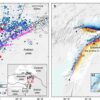The seasonal reversal of land-sea thermal contrast drives the monsoon system—the dominant seasonal mode of the global hydrological cycle that influences the livelihood of billions of people. But how did the modern global monsoon develop?
A joint research team led by Prof. Hu Yongyun from Peking University and Prof. Guo Zhengtang from the Institute of Geology and Geophysics of the Chinese Academy of Sciences (IGGCAS) recently demonstrated that tectonics—not large global climatic fluctuations—caused the emergence of the modern global monsoon from the Pangea megamonsoon.
The study was published in Nature Geoscience on Oct. 19.
Over tectonic timescales, continents undergo the Wilson Cycle, a process of supercontinental breakup and the reassembly of fragmented continents. Although this tectonic process has long been understood, scientists did not know how the evolution of continents impacted the monsoon system over time.
Pangea—the most recent supercontinent—broke up about 180 million years ago (Ma), according to scientific estimates. Highly fragmented continents were most widespread in the late Cretaceous and later reassembled in the Cenozoic.
Combining a novel set of climate simulations with geological records, the research team showed that the evolution of the global monsoon system experienced three stages since Pangea: First, the supercontinent Pangea led to a broad land-monsoon area (i.e., megamonsoon), but with modest monsoonal precipitation. Later, highly fragmented continents in the Cretaceous caused a much smaller land-monsoon area, but with much heavier monsoon precipitation.
Finally, as continents reassembled in the Cenozoic, the land-monsoon area became large, while land-monsoon precipitation intensity became weak. The global land-monsoon area is highly negatively correlated with monsoon precipitation intensity, with a correlation coefficient of -0.87.
These findings indicate that the global land monsoon is governed by continental area, latitudinal location, and fragmentation. The results also show that continental area—particularly tropical continental area—determines land-monsoon area, while continent fragmentation determines land-monsoon precipitation intensity.
“Greenhouse gas-induced temperature changes have a very minor effect on land monsoons over geological time,” said Prof. Guo. “The modern global land monsoon did not directly originate from the Pangea megamonsoon but emerged after the reassembly of fragmented continents in the Cenozoic.”
The results of the spatial and temporal evolution of land-monsoon area and intensity since Pangea offer a broad perspective for further exploring the link between the global monsoon and Earth’s climate history.
“Our study provides significant insights into the evolution of regional ecosystems and the formation of exogenetic ore deposits, all of which are strongly dependent on temperature and monsoon precipitation,” said Prof. Hu. “Monsoon-related chemical weathering of silicate rocks has also been shown to strongly influence atmospheric CO2 concentration, consequently affecting the global climate.”
More information:
Yongyun Hu et al, Emergence of the modern global monsoon from the Pangaea megamonsoon set by palaeogeography, Nature Geoscience (2023). DOI: 10.1038/s41561-023-01288-y
Provided by
Chinese Academy of Sciences
Citation:
Study reveals transition from Pangea megamonsoon to modern global monsoon (2023, October 25)



